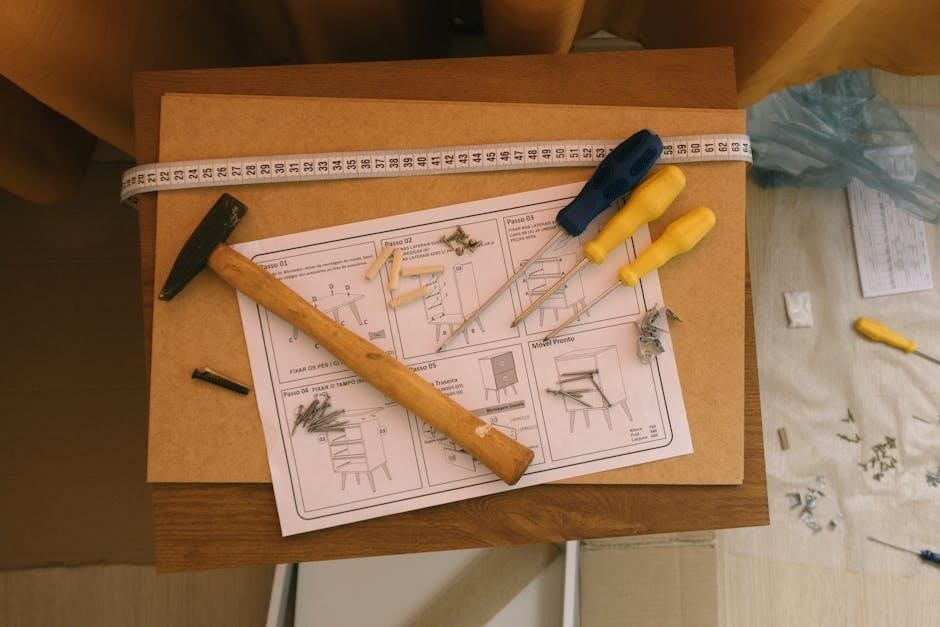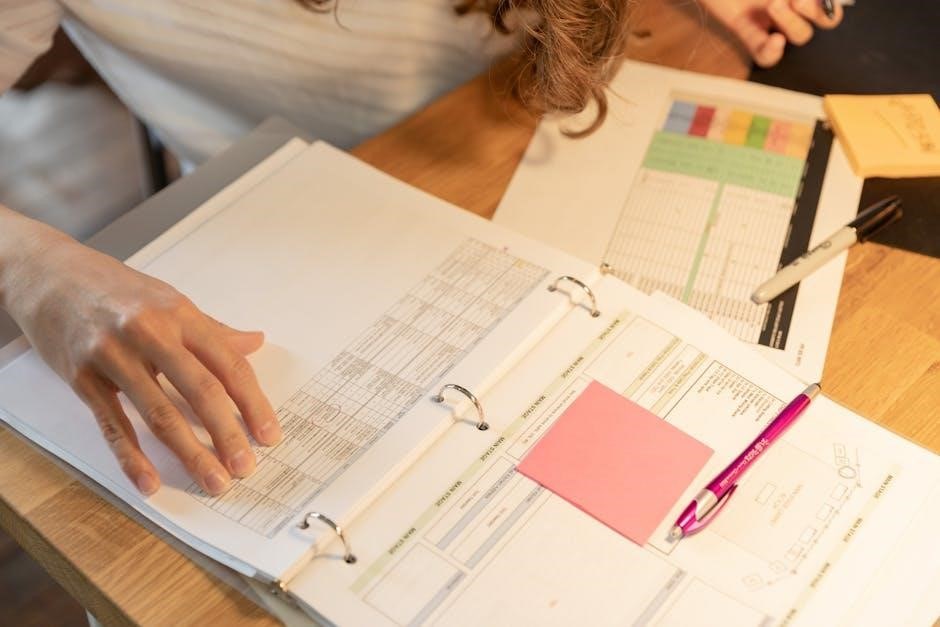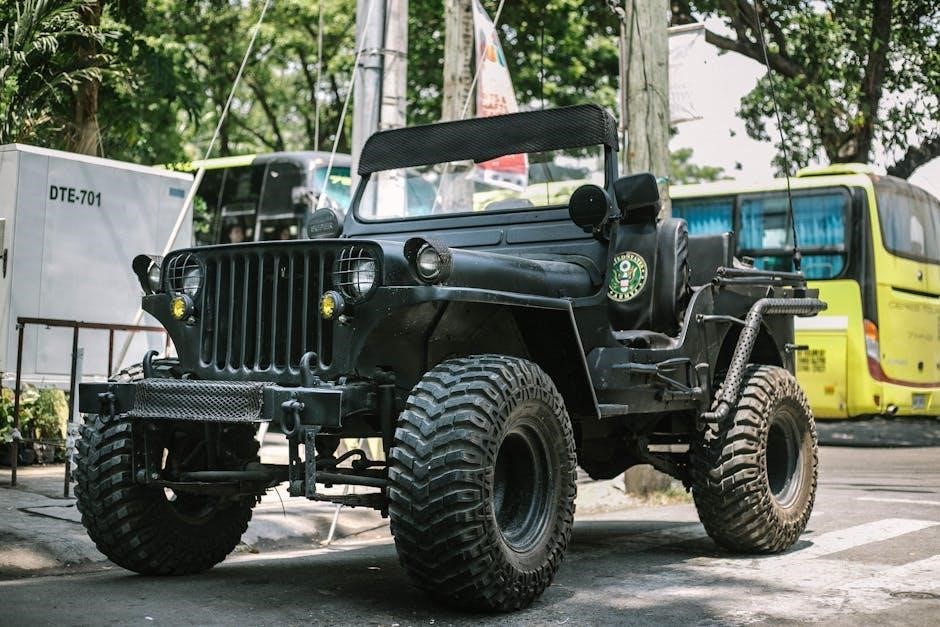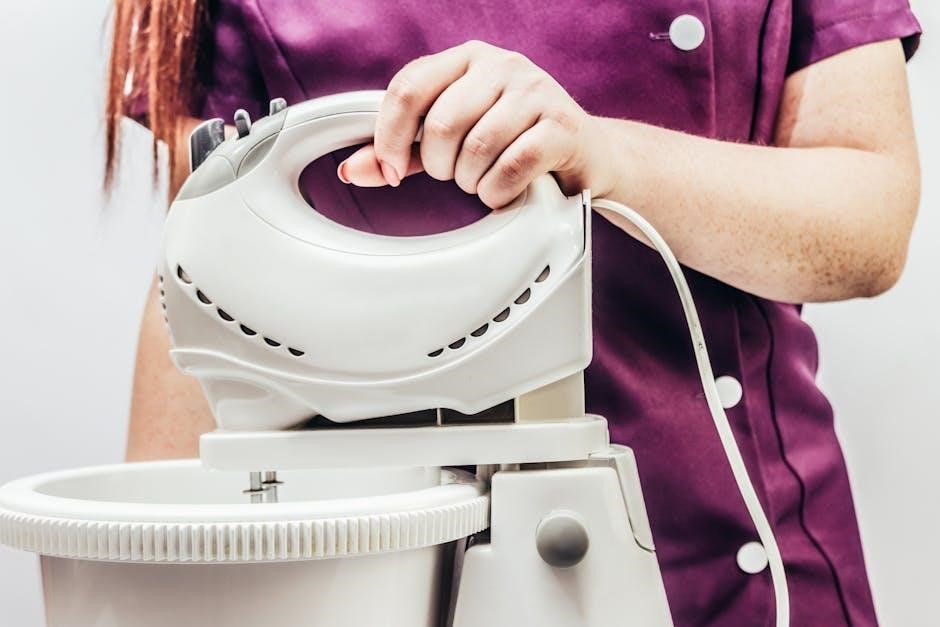The George Foreman Grill is a revolutionary kitchen appliance designed for healthy, fat-reducing grilling․ Endorsed by the boxing legend, it offers easy cooking for meats, vegetables, and sandwiches․
Overview of the George Foreman Grill
The George Foreman Grill is a versatile, indoor electric grilling appliance designed for healthy cooking․ It features a sloped surface that allows fat and grease to drip away, reducing calorie intake․ Suitable for meats, vegetables, and sandwiches, it ensures even cooking with minimal effort․ The grill is compact, easy to use, and clean, making it a practical addition to any kitchen․ Before first use, users are advised to read the manual carefully to understand its operation and maintenance․ This ensures safe and effective grilling experiences while preserving the appliance’s longevity․
Importance of Reading the Manual
Reading the manual is essential for safe and effective use of the George Foreman Grill․ It provides critical information on assembly, operation, and maintenance․ The manual outlines safety precautions, such as avoiding hot surfaces and ensuring the grill is placed on a stable surface․ It also guides users on proper cleaning and storage to prevent damage․ By following the manual, users can optimize grilling performance, avoid potential hazards, and extend the appliance’s lifespan․ Neglecting to read the manual may lead to improper use, safety risks, or damage to the grill․ Always refer to the manual before first use․
Key Features of the George Foreman Grill
The George Foreman Grill is a Lean Mean Fat Reducing Grilling Machine, designed to cook food evenly while draining excess fat․ It features non-stick grilling plates for easy food release and cleanup․ The sloped design allows fat to drip into a removable drip tray, promoting healthier cooking․ The grill also includes adjustable heat settings for precise temperature control․ Its compact size makes it ideal for indoor use, while the portable design allows for easy storage and transport․ These features combine to make the George Foreman Grill a versatile and efficient cooking appliance for a variety of dishes․
Safety Precautions
Always read the manual before use to ensure safe operation․ Avoid overheating and never leave the grill unattended․ Keep children away and use oven mitts for protection․
General Safety Guidelines
Always read the manual before using the George Foreman Grill․ Ensure the grill is placed on a stable, heat-resistant surface․ Keep children away from the appliance while in use․ Use oven mitts or tongs to handle hot surfaces․ Avoid overheating by monitoring the grill during operation․ Never leave the grill unattended while it is in use․ Clean the grilling plates before the first use to ensure optimal performance․ Follow all safety precautions to prevent accidents and maintain the longevity of your grill․
Electrical Safety Tips
Always read the manual before using the George Foreman Grill․ Ensure the grill is placed on a stable, heat-resistant surface․ Keep children away from the appliance while in use․ Use oven mitts or tongs to handle hot surfaces․ Avoid overheating by monitoring the grill during operation․ Never leave the grill unattended while it is in use․ Clean the grilling plates before the first use to ensure optimal performance․ Follow all safety precautions to prevent accidents and maintain the longevity of your grill․
Handling Hot Surfaces
The George Foreman Grill’s surfaces become extremely hot during operation․ Always use oven mitts or tongs to handle the grill or plates․ Avoid direct contact with the grilling plates or machine body while cooking․ Keep children away from the grill to prevent burns․ Ensure the grill is placed on a heat-resistant surface to avoid damage or fire hazards․ Never touch the grill with wet hands or while standing on a damp surface․ Allow the grill to cool down completely before cleaning or storing it․ Always prioritize caution when handling hot components to ensure safe and enjoyable grilling experiences․
Components and Accessories
The George Foreman Grill includes a grill machine body, grilling plates, a removable drip tray, and a power cord․ These components ensure efficient and safe grilling․
Grill Machine Body
The George Foreman Grill’s machine body is durable and compact, designed for efficient cooking․ It features a sloped surface to reduce fat and a non-stick coating for easy food release․ The body includes a cool-touch handle for safe operation and a power cord for convenient electricity connection․ Always place the grill on a stable, heat-resistant surface to ensure safety and even cooking․ Regular cleaning of the machine body is essential to maintain its performance and hygiene․ Follow the manual’s guidelines for proper care and storage to extend the grill’s lifespan and keep it in optimal condition for years of use․
Grilling Plates
The George Foreman Grill features non-stick grilling plates designed to reduce fat and ensure easy food release․ These plates are removable for convenient cleaning and are coated with a durable, non-stick surface․ Before first use, wipe the plates with a damp cloth to prepare them for cooking․ Avoid using metal utensils, as they may scratch the non-stick coating․ For maintenance, clean the plates with a soft sponge and mild detergent; Never submerge the plates in water or use abrasive cleaners, as this may damage the non-stick layer․ Proper care ensures the plates remain effective and long-lasting for optimal grilling performance․
Removable Drip Tray
The George Foreman Grill includes a removable drip tray designed to collect excess fat and grease during cooking․ This feature promotes healthier grilling by allowing fats to drain away from food․ The drip tray is easy to remove and clean, ensuring mess-free cooking sessions․ Regularly emptying and washing the tray with mild detergent helps maintain hygiene and prevents grease buildup․ Avoid using abrasive cleaners or scouring pads, as they may damage the tray’s surface․ Proper maintenance of the drip tray ensures optimal performance and longevity of your George Foreman Grill․
Power Cord and Plug
The George Foreman Grill comes with a power cord and plug designed for safe and efficient operation․ Always use the provided cord to ensure compatibility and avoid damage․ Plug the grill into a grounded electrical outlet rated for the specified voltage․ Never use a damaged cord or plug, as this could pose a safety hazard․ Keep the cord away from hot surfaces and avoid overloading the outlet․ Store the cord neatly when not in use to prevent tangling or damage․ Proper care of the power cord and plug ensures reliable performance and longevity of your grill․

Assembly and Initial Setup
Unpack the grill carefully, ensuring all components are included․ Wash the grilling plates with a damp cloth before first use․ Place the grill on a stable, heat-resistant surface․
Unpacking the Grill
When unpacking your George Foreman Grill, carefully remove all components from the box․ Ensure the grill machine body, grilling plates, drip tray, and power cord are included․ Inspect for any damage or defects․ Place the grill on a stable, heat-resistant surface․ Before first use, wipe the grilling plates with a damp cloth to remove any manufacturing residue․ Refer to the manual for specific unpacking instructions․ Ensure all safety precautions are followed to avoid accidents․ Proper unpacking ensures optimal performance and longevity of your grill․
Washing Before First Use
Before using your George Foreman Grill for the first time, wash the grilling plates and drip tray with warm, soapy water․ Use a soft sponge or cloth to avoid scratching the surfaces․ Rinse thoroughly and dry with a clean towel․ Do not use abrasive materials or harsh chemicals, as they may damage the non-stick coating․ Wipe the grill machine body with a damp cloth to remove any dust or packaging residue․ Ensure all parts are completely dry before assembling and plugging in the grill․ This step ensures a clean and safe first-use experience․
Placing the Grill on a Stable Surface
Place the George Foreman Grill on a stable, heat-resistant surface, ensuring it is level and secure․ Avoid uneven or flammable surfaces, such as plastic or fabric․ Keep the grill away from direct heat sources or open flames․ Ensure the surface is clean and dry to prevent any slipping․ Position the grill in a well-ventilated area to avoid smoke accumulation․ The drip tray should be properly aligned and placed underneath to catch excess grease․ Always follow these guidelines to ensure safe and efficient grilling․ Proper placement is essential for optimal performance and safety․
Operating the George Foreman Grill
Plug in the grill, preheat it, and cook your food evenly․ Ensure the drip tray is in place to catch excess grease during cooking for a mess-free experience․
Plugging in the Grill
Before plugging in the George Foreman Grill, ensure it is placed on a stable, heat-resistant surface․ Locate the power cord at the back of the grill machine body and plug it into a nearby electrical outlet․ Make sure the outlet is not overloaded and is protected by a fuse or circuit breaker․ Avoid using extension cords to prevent potential safety hazards․ Once plugged in, the grill is ready for preheating․ Always refer to the user manual for specific instructions tailored to your model․
Preheating the Grill
Before cooking, preheat the George Foreman Grill by plugging it in and ensuring it is placed on a stable, heat-resistant surface․ Allow the grill to preheat for 3-5 minutes․ The preheat light will illuminate, indicating the grill is heating up․ Once the light turns off and you hear a clicking sound, the grill is ready for use․ Never leave the grill unattended during preheating․ Ensure the grilling plates are clean and dry before preheating to prevent food residue from burning․ Always refer to the user manual for specific preheating instructions tailored to your model․
Cooking on the Grill
Place food gently on the preheated grilling plates, ensuring even distribution․ Cook meats, vegetables, and sandwiches evenly; Avoid overcrowding to ensure proper cooking․ Close the lid to trap heat and reduce cooking time․ For meats, cook to the recommended internal temperature․ Vegetables and sandwiches typically require 2-4 minutes․ Use the drip tray to collect excess fat․ Never flip food with a sharp object to avoid damaging the plates․ Allow food to cook undisturbed for optimal results․ Always use oven mitts or tongs to handle hot food․ Refer to the manual for specific cooking times and temperatures for different food types․
Adjusting Heat Settings
Use the temperature control knob or button to adjust heat levels․ Select from low, medium, or high settings based on the type of food․ For meats, high heat sears effectively, while medium heat suits vegetables and sandwiches․ Preheat the grill until the indicator light confirms the desired temperature․ Always monitor cooking to avoid overheating․ Adjust settings as needed during cooking to ensure even results․ Refer to the manual for specific heat recommendations for different foods․ Proper heat adjustment ensures optimal cooking performance and prevents food from burning․
Cooking Times and Temperatures
Cooking times vary by food type․ Meats typically require 4-7 minutes per side, vegetables 3-5 minutes, and sandwiches 2-4 minutes․ Use medium-high heat for best results․
Recommended Cooking Times for Meat
Cooking times for meat on the George Foreman Grill vary by type and thickness․ Boneless chicken breasts typically take 5-7 minutes per side, while ground beef or pork patties require 4-5 minutes per side․ Steaks, depending on thickness, cook in 5-7 minutes per side for medium-rare․ Always use a food thermometer to ensure safe internal temperatures: 165°F for chicken and 160°F for ground meats․ Let meat rest for a few minutes after cooking to retain juices․ Adjust times slightly for well-done or rare preferences, ensuring food safety and optimal flavor․
Recommended Cooking Times for Vegetables
Vegetables cook quickly on the George Foreman Grill, with most requiring 3-5 minutes per side․ Sliced zucchini, bell peppers, and onions take about 3-4 minutes, while denser vegetables like carrots or sweet potatoes may need 5-7 minutes․ Check for tenderness and slight charring to determine doneness․ For optimal results, slice vegetables evenly and brush with oil before grilling․ This ensures even cooking and prevents sticking, making your grilled vegetables crispy and flavorful․ Adjust times based on thickness and desired crispiness for perfect results every time․
Recommended Cooking Times for Sandwiches
Sandwiches on the George Foreman Grill typically cook for 3-4 minutes per side․ Thicker sandwiches or those with denser fillings may require an extra 1-2 minutes․ Use a gentle touch to avoid pressing too hard, which can push out fillings․ Cook until the bread is golden brown and the inside is heated through․ For extra crispiness, lightly toast the bread before grilling․ This ensures a perfectly cooked sandwich every time․
Cleaning and Maintenance
Regular cleaning is essential for maintaining your George Foreman Grill’s performance․ Wipe down the exterior with a damp cloth and dry thoroughly after each use․
Cleaning the Grilling Plates
Regular cleaning of the grilling plates is essential for optimal performance․ Before cleaning, unplug the grill and let it cool slightly․ Use a damp cloth to wipe down the plates, removing any food residue․ For tougher stains, mix baking soda and water to create a paste, apply it to the plates, and let it sit for 10-15 minutes․ Avoid using abrasive cleaners or metal scourers, as they may damage the non-stick surface․ After cleaning, rinse the plates with warm water and dry thoroughly to prevent rust․ This maintenance ensures your grill remains in great condition for future use․
Cleaning the Drip Tray
Regularly cleaning the drip tray is crucial for maintaining hygiene and preventing grease buildup․ Remove the tray from the grill and wash it with mild soap and warm water․ Avoid using abrasive cleaners or scrubbers, as they may damage the surface․ For tough stains, soak the tray in soapy water for 15-20 minutes before scrubbing gently․ Rinse thoroughly and dry with a clean towel to prevent water spots․ Reattach the drip tray securely after cleaning to ensure proper function during grilling․ Regular maintenance helps keep your George Foreman Grill in optimal condition for years of use․
Storing the Grill
Proper storage of your George Foreman Grill ensures longevity and safety․ Always unplug the grill and allow it to cool completely before storing․ Use a protective cover to prevent dust accumulation․ Store the grill in a dry, cool place, away from direct sunlight․ Avoid stacking heavy objects on top of the grill to prevent damage․ If storing for an extended period, clean the grill thoroughly beforehand․ Ensure all accessories, like the drip tray, are also clean and dry before storage․ Proper storage maintains the grill’s performance and keeps it ready for future use․

Troubleshooting Common Issues
Common issues include the grill not heating, excessive smoke, or food sticking․ Refer to the manual for solutions, such as cleaning plates or adjusting heat settings properly․
Grill Not Heating Up
If the grill fails to heat, ensure the power cord is securely plugged into a working outlet․ Check for any damage to the cord or plug․ Verify that the grill is properly assembled and that the heating elements are clean․ If issues persist, consult the user manual or contact customer support for assistance; Regular maintenance, such as cleaning the grilling plates, can also prevent heating problems․ Always follow the manufacturer’s guidelines for troubleshooting to ensure safety and optimal performance․
Excessive Smoke
Excessive smoke may occur due to food residue or high heat settings․ To resolve this, clean the grilling plates regularly and ensure the drip tray is empty․ Lowering the heat or preheating properly can also help․ Avoid overcrowding the grill, as this can cause food to steam instead of sear․ Always pat dry foods before grilling to reduce moisture․ If smoke persists, check for blockages in the grill vents and ensure proper ventilation in the cooking area․ Regular maintenance and following the manual’s cleaning guidelines can prevent excessive smoke issues․
Sticking Food
Food sticking to the grilling plates can be prevented by ensuring the grill is preheated properly and lightly oiled․ Always pat dry foods before grilling to remove excess moisture․ Avoid using metal utensils, as they can scratch the non-stick surface․ If food sticks, allow it to cook a bit longer before gently loosening with a plastic spatula․ Cleaning the plates after each use and reapplying a small amount of oil can maintain their non-stick properties․ Regular maintenance and following the manual’s care instructions will help prevent sticking and ensure optimal performance․

Storage and Portability
The George Foreman Grill should be stored upright in a dry place․ Its compact design and built-in handles make it easy to transport and store efficiently․
Proper Storage Techniques
To maintain your George Foreman Grill’s performance, store it upright in a cool, dry place․ Ensure the grill and drip tray are clean and dry before storage to prevent rust or mold․ Remove any accessories and store them separately․ Avoid stacking heavy objects on the grill to prevent damage․ For portability, use the built-in handles to transport the grill safely․ Always check for any damage or wear before storing or transporting․ Proper storage ensures longevity and keeps your grill ready for its next use․
Transporting the Grill

When transporting your George Foreman Grill, ensure it is clean and dry to prevent damage or moisture buildup․ Use the built-in handles to lift and move the grill securely․ Avoid tilting the grill excessively, as this may cause components to shift or liquid to spill․ Always place the grill on a stable, flat surface during transport to maintain balance․ For longer trips, consider wrapping the grill in a protective cover to shield it from dust or scratches․ Never transport the grill while it is hot or in use․ Always check for any damage before moving the grill․

Additional Tips for Perfect Grilling
Marinate meats and vegetables beforehand for enhanced flavor․ Lightly oil grilling plates to prevent sticking․ Cook in batches to ensure even cooking and avoid overcrowding the grill․
Marinating and Seasoning
Marinating your food before grilling enhances flavor and tenderness․ Use a mix of herbs, spices, and acids like vinegar or citrus for meats and vegetables․ For best results, marinate for at least 30 minutes to several hours․ Seasoning with salt, pepper, and other spices before cooking adds depth to your dishes․ Pat dry excess moisture from marinated food to ensure even cooking and prevent steaming․ Lightly oil the grilling plates to prevent sticking and promote even browning․ Proper seasoning and marinating techniques make your grilling experience more enjoyable and flavorful․
Using Oil on the Grilling Plates
Lightly applying oil to the grilling plates prevents food from sticking and ensures even cooking․ Use a small amount of cooking spray or a paper towel dipped in oil to coat the plates evenly․ Avoid excessive oil to prevent smoke and splatter․ This step is crucial before preheating the grill and adds a protective layer to the non-stick surface․ Properly oiled plates enhance the grilling experience and make cleanup easier․ Always oil the plates before cooking to maintain their condition and achieve the best grilling results․

Avoiding Overcrowding the Grill
Avoid overcrowding the grill to ensure even cooking and prevent food from sticking․ Overcrowding can lead to uneven heat distribution, causing some areas to cook faster than others․ This may result in undercooked or overcooked food․ By leaving adequate space between items, you allow air to circulate properly, promoting consistent grilling․ Overcrowding also makes flipping and handling food more difficult․ For optimal results, cook in batches if necessary, ensuring each piece has enough room to cook evenly․ This practice enhances the overall grilling performance and ensures a perfect finish for your meals․

Warranty and Support
Your George Foreman Grill comes with a warranty covering defects in materials and workmanship․ For assistance, contact customer support via phone, email, or the official website․
Understanding Your Warranty
Your George Foreman Grill is backed by a warranty that covers manufacturing defects for a specified period․ The warranty typically includes repair or replacement of faulty parts․ To ensure coverage, register your product online or via mail within the required timeframe․ Keep your purchase receipt and warranty document safe, as they are essential for any claims․ The warranty does not cover damage caused by misuse or improper maintenance․ For detailed terms, refer to the warranty section in your manual or visit the official website․ Understanding your warranty ensures peace of mind and protection for your investment․
Contacting Customer Support

For assistance with your George Foreman Grill, visit the official website to access support resources․ You can search for your user manual by model number or appliance name․ Contact customer support via phone, email, or live chat for inquiries or issues․ Ensure you have your model number ready for efficient assistance․ The website also offers troubleshooting guides and warranty information․ For further help, register your product online to gain access to exclusive support options․ Reach out to the dedicated team for any concerns, ensuring a smooth experience with your grill․
With proper use and care, your George Foreman Grill will provide years of delicious, healthy meals․ Enjoy experimenting with recipes and techniques for perfect grilling results every time!

Final Tips for Enjoying Your George Foreman Grill
For the best experience, always marinate meats and season vegetables before grilling․ Lightly oil the plates to prevent sticking and ensure even cooking․ Avoid overcrowding the grill for consistent results․ Clean the grill after each use to maintain its performance and longevity․ Experiment with different recipes to explore the full potential of your George Foreman Grill․ Proper storage and regular maintenance will extend its lifespan, ensuring countless delicious meals for years to come․ Happy grilling!
